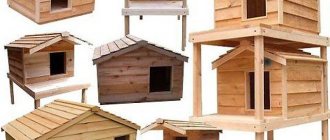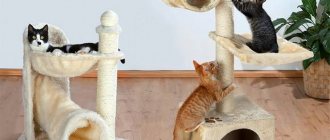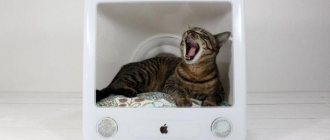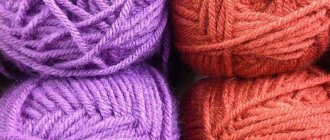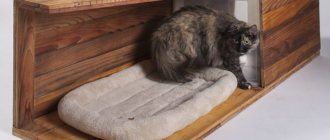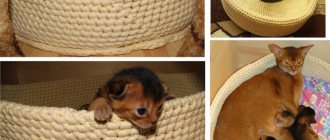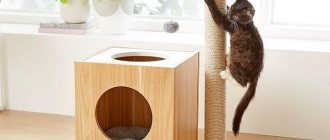Select an option
Building a house for a cat will not be difficult; it is enough to take into account a number of factors that take into account the behavior of the animal. If you approach the problem formally, then you can make a house, but it will simply take up space and gather dust. First of all, you should observe the animal to determine where the cat likes to rest. Most cats prefer to climb to heights, hiding in a secluded place, although there are some that simply rest on the floor. In this case, a lot depends on the breed of the animal.
First you need to decide on the choice of design
Design approaches
Not all cats behave the same way, so the approach can be highly individual. It is typical for cats to have two passages into the house, which is associated with the evacuation of the offspring in case of danger, although many owners castrate or sterilize their animals in a timely manner. To build a house, you can use pipes or other similar structures. However, they do not like wide openings, as this leads to a feeling of danger. In this regard, the entrance to the house should be narrow enough so that the animal can crawl into it freely. Most cats prefer heights, and in houses on the floor they can live with their offspring. If cats do not have offspring, then they will choose a larger house located at some distance from the floor, although, as mentioned above, everything is purely individual.
Cats prefer upper floors
Cats will definitely choose a higher place with a good view, as they love to watch what is happening around them. They prefer to be on platforms and are rarely seen lying in the house. For a cat, it is important that there are many areas, and of such a size that the animal can lie on them at full length. Such areas do not need to be fenced, since cats feel comfortable at heights. If owners make fences, it’s more for their own peace of mind, but cats don’t need them.
Place for a cat
If the cat does not have offspring, then cats, no less than cats, love to be on sites and watch everything that happens from above. At the same time, one should not ignore the desire of a cat, like a male cat, to sometimes retire and relax so that no one disturbs them. At the same time, it should be noted that there are breeds that are not intrusive in their behavior and try to retire. Therefore, both cats and cats need a house.
Adding some elements
The term “cat house” should be understood as a whole complex of elements with platforms and other useful additions. As a rule, animals choose the areas they like, and appear on some of them quite rarely. It is quite difficult to determine in advance which of the areas the animal will like, which is why it is necessary to build a whole complex.
Additional, but very useful elements in the cat complex are scratching posts and climbing frames. Scratching posts are vertical surfaces wrapped in ropes made from natural ingredients, while climbing frames are horizontal and inclined surfaces designed to allow the animal to move between different levels of the complex. By the way, scratching posts are also used by animals to climb onto the upper tiers or platforms.
Hammocks and claw pads
A hammock is another element that will not interfere with a cat’s complex. It is a rectangular piece of fabric that is attached to two crossbars. You can make the frame rigid and hem fabric to it, after which the frame is attached to the base at 4 corners.
As an option, it is permissible to hang toys on strings that animals simply adore and can play with for hours.
Cats simply love pipes that are made of fabric. To make the structure rigid, wire is inserted around the perimeter into the ends of the pipe. One end of the pipe should be raised to a certain height, and the second should be left on the floor. There must be a gap at the end of the pipe, otherwise the cat will ignore such an element. Animals can spend a lot of time in pipes because they feel like hunters in ambush.
Fabric pipes
Few people know that cats really like it if you take clothing brushes and attach them to a vertical surface, somewhere at the level of the animal’s back. Cats simply love to scratch themselves on these surfaces, which are made of medium-hard artificial bristles.
At what altitude
For any cat, the higher the resting place is located, the better, since in such conditions they feel safe. Therefore, in such cases, the cat house can be located even under the ceiling itself. Regardless of how many tiers there are in this complex, the top one will be mostly occupied. If there are several cats, then the leader will be located on the top “floor,” but despite this, this “floor” will remain controversial for the animals and each of the cats will want to be the first to occupy it.
Place right under the ceiling
It is believed that the smallest height of a cat's corner is one meter. A low height appears to be safe even for small kittens, but as they age, they will still move to higher tiers when they feel that they are capable of it.
Options for walls
The best option is to place a seating area on the wall, since it can take up about 1 square meter on the floor. Considering our apartments, where every square meter counts, a place for a cat on the floor is quite problematic, but placing it on the wall is not a problem at all, just secure it properly. Several platforms can be secured and connected by transitions from boards, placing them at different angles. As an option, you can use rope ladders, which the animals will certainly enjoy. In other words, there is a huge field for imagination, but at the same time you also need to have desire.
Wall options
Such elements are also called shelves for cats, since they are quite similar to shelves for books, since their fastening is identical. Cats and cats happily exploit such feline complexes.
Built into furniture
Enterprising owners can come up with anything they can, and often adapt existing furniture into a cozy pet’s refuge .
The following pieces of furniture can be turned into a cat house:
- a cabinet or small cabinet (bedside), cutting out a passage in the door;
- a sofa by attaching cardboard or fabric tunnels to it, or placing a shelf with a lounger on the side;
- a bookcase with a ladder attached so that the cat could use it to get to the very top and hide there;
- a table or chair with a soft fabric hammock secured under it;
- table, making an additional lower shelf with a lounger, pillow;
- open shelves of cabinets, placing beds or low baskets or boxes on them;
- shelves for flowers, setting aside the bottom shelf for the pet and the top for flowers.
For such transformations you will need simple tools that can be found in any home:
- scissors, needle and thread;
- hammer, nails;
- screwdriver, self-tapping screws;
- jigsaw (manual or electric);
- glue, stapler for furniture.
House for a cat from a chair
What materials?
A cat house is usually made from leftover building materials or other elements that are no longer needed. This is quite acceptable, since all structural elements will have to be covered with fabric, some other textile, or wrapped with ropes. Despite this, even such materials have a number of requirements.
Due to this:
- They should not have any foreign, especially pungent, odors. In any case, those living in the house should not feel it, and animals even less so, since their sense of smell is much sharper. If these are natural odors, then they are allowed. If any material still has a bad aroma, then you can leave it outside for a while.
Not harmful materials - Do not use materials that tend to accumulate electrical charges. These include open surfaces made of plastic, materials made of wool or silk. Animals are quite sensitive to electrical discharges.
In order for a cat to begin mastering this complex as quickly as possible, it needs to be kept in the home for some time. This is necessary so that the structure completely absorbs the aromas of the room familiar to the animals.
Basic materials
A cat complex can consist of several elements, which are made from various available materials. That's why:
- The house can be made from plywood, chipboard, thin boards, woven from twigs, from newspaper tubes, etc.
- Vertical and inclined elements are manufactured:
- From plastic pipes for sewerage, from paper pipes, which can be placed in a tree trunk, in a wooden beam, or wrapped with a piece of linoleum.
- From ordinary boards, chipboard or fabric, placing them at different angles.
- Hammocks are made of fabric, ropes, and a regular wooden slatt is used as a frame.
Platforms are made of wood, chipboard, plywood, etc. If the platform is made of wood, then it does not need to be covered with fabric, but it will have to be sanded and also coated with water-based varnish. If the material is chipboard or plywood, then it is better to enclose them in fabric, since chemical components are used in their manufacture.
Platforms made of wood and plywood
It is permissible to take a tree trunk as the basis for a cat complex, but there is no need to remove the branches completely, leaving some of them in order to attach platforms, a house and other elements to them. To do this, take a tree trunk about 2 meters high, after which the branches are cut off so that 20-30 centimeters remain. After this, the bark is removed from the trunk. Such a complex for animals will be especially interesting, since it has a natural base, but we must not forget that it needs to be well strengthened.
Sheathing material
To get a scratching post, just wrap a thick rope made of natural material, such as hemp, for example, around the base. If the complex is not made of wood, then it will have to be completely wrapped with rope, so it will take quite a lot of it.
To sheathe houses and shelves, you can use a dense material such as carpet, but you should not use carpet with a long pile. The long pile facilitates the rapid collection of dust and dirt, along with animal hair. In turn, this can cause allergic reactions, both in the cats themselves and in the residents.
Carpet upholstery
The color of the upholstery does not matter at all, especially for cats, but for the owner this is an interesting question, since the best option is a combination of the color of the cat complex with the interior of the human home.
Fastening
The most important thing is that the design is absolutely safe for the animal. All fastening elements must be hidden, and if necessary, they are covered with putty or sheathed with fabric.
Cat climbing frames with platforms
Equally important is to securely secure the entire structure, especially if it is used by more than one cat. Their games can lead to the fact that the entire structure may collapse, and the higher it is, the greater the likelihood.
Example photo with dimensions
To understand how much space a cat complex can take up, just look at the ready-made drawings with dimensions. After this, you can begin designing the cat house. It should be borne in mind that cats come in different breeds and may differ in size, although not significantly. The design of the house also depends on how much usable space needs to be sacrificed for the pet.
The photo shows that the height of these structures is within 1 meter 80 centimeters, or even higher, although this is not critical and you can easily remove the extra centimeters along with the floors. These drawings can serve as a good basis for building a house for your cat. Based on the existing drawing, you can begin to prepare all the necessary materials, after which you can begin assembling this structure.
Bed
A cat bed can be made of cardboard, newspaper tubes, or foam rubber. The shape of this resting place is selected in accordance with the size of the cat or its preferences in relaxation.
Cat bed made from an old sweater
Some prepare beds similar to the existing interior in the apartment. The main thing in this matter is to provide your pet with comfort and warmth. Therefore, do not forget about using foam rubber, soft fabric and other textile materials.
Soft fabric bed
Step-by-step production of a complex for two cats
When an owner has two cats, it is necessary to build a house for them taking into account their behavior, and so that they do not interfere with each other. The behavior of cats can be different: some cats are friends and easily get along on the same site, and there are times when one of them dominates. In this case, we can assume that one of them will want to take the most comfortable and highest place. If the cats are not friends, then it is better to separate the platforms, but if they are friends, then you can build one common, but large platform at the very top of the structure.
Materials and finished house
For this design, plywood up to 12 mm thick is suitable, as well as pillars made of wooden beams measuring 50 by 70 mm and at least 4 meters long. You will also need a jute-based carpet, about 2 and a half square meters, and a rope up to 20 meters long. Corners with a side of 15 by 20 mm for the house and 40 by 45 mm for attaching platforms are suitable as fasteners. For fastening to the wall, you can use a pair of large corners, measuring 50 by 50 mm.
Fastening the main elements
The basis is a structure consisting of 3 pillars of different heights: 220 cm, 120 cm and 80 cm. The pillars are securely attached to the base, which is a plywood sheet. These load-bearing elements are placed so that the longest one is as close to the wall as possible in order to securely secure the entire structure. The placement of the posts is marked directly on the plywood sheet using a pencil. The posts can be secured using long nails driven into the back of the sheet, but first holes of the appropriate diameter are drilled for them. For reliability, the pillars are fastened with metal corners of the appropriate size.
Marking
Using the same method, holes are marked in the platforms through which the pillars should pass. It is better to make the holes slightly larger than the size of the posts, since they are still attached using corners. If the holes turn out to be somewhat smaller, then they will then have to be further processed either with a file, or a jigsaw, or sandpaper.
Fastening platforms
Before attaching the platform, it should be tried on and, if necessary, adjusted to size. It is desirable that the platform, and all other elements, be fixed strictly horizontally. To do this, you can use a building level. For reliability, the platform is attached using corners. After this, all platforms are covered with carpet, and this must also be done reliably, otherwise the animals will tear it away from the base.
House assembly
The body of the house is assembled from 4 rectangular pieces of plywood, which serve as the walls of the house, and a hole should be cut in one of the rectangles so that the cat can crawl through it. For the floor and roof, another rectangular section is cut out. To connect all the elements of the house, it is enough to use small metal corners and self-tapping screws. The fasteners must be such that none of the elements, especially the sharp ones, come out, although many of the fastener elements will be located under the skin.
Ship assembly
The most important thing is not to forget to upholster the house from the inside, after which you can fasten the roof, which is also sheathed with the same material. The finished house is attached to the planned location using the same metal corners as in the case of platforms.
Wrapping ropes around poles
The last stage is wrapping the poles with ropes, which will serve as scratching posts for the animals. In addition, design elements for animals will be more attractive. Before wrapping the rope around the pole, it is secured with a bracket. Staples are also used for intermediate fastening of ropes, as well as for final fastening. The rope should be wound tightly, otherwise it will loosen over time. To prevent this from happening, each turn or several are compacted at once with a hammer.
Wrapping poles with ropes
Building a cat house with your own hands does not take much time and can take no more than half a day, although more complex designs take much longer. In the following video you can see how a similar structure is assembled.
How I built a cat house with my own hands. The cat is SHOCKED! /How To Make a Cat House
DIY wigwam
The house in the form of a wigwam looks fresh and provocative . At home, you can quickly and easily build it from cardboard or fabric.
Wigwam for a cat made of cardboard
The following materials will be required:
- 6 twigs or branches - the basis of the frame. The upper ends are fastened together, the lower parts are widely spaced in different directions for stability.
- Scotch tape or rope - to secure the rods.
- Cardboard is the bottom of the wigwam. A hexagon is cut out and covered with fabric (preferably water-repellent).
- Glue or needle and thread - for holding fabric together.
- The fabric is cut into 6 isosceles triangles, in one of which a slot is made for the entrance.
The parts of the material are sewn together in such a way that rods can be inserted into the seam between the pieces of fabric. The frame is inserted into the stitched tent, and the bottom edges of the material are sewn to the bottom of the cardboard base.
Wigwam for cats made of fabric
A cat house in a few minutes
The simplest version of a cat house will not require much time and many parts to assemble. That's why:
- It is enough to have a cardboard box of suitable sizes.
- You will need an old T-shirt as a covering material.
You also cannot do without tape to secure the entire structure. As for tools, you can get by with an ordinary knife, but quite sharp, and scissors. Making such a house will only take a couple of minutes, which can be seen in the video.
How to make a house for a cat? We make a house for a cat with our own hands in 2 minutes!
Sew a hammock
Make it easier than ever! This original cat house can be hung from the legs of a chair, on a wooden support, or using hangers.
The simplest hammock does not require any special circuits. Cut two identical rectangles from fabric and sew them together. You can form “passages” on the sides, through which you can then thread holding ropes. You can also separately sew loops of fabric to the corners, from which you will hang the structure.
Photo: hu.gardendecorgalore.com
Photo: mashalove.ru
A selection of photos of interesting cat complexes (houses)
This section is dedicated to interesting solutions that are embodied in the designs of cat houses, as well as entire complexes. It is not surprising that a person takes care of their pets, since, living next to a person for many years, they become members of the family. Such designs deserve attention!
scratching post
A scratching post is an important and necessary attribute; it should be used from the first days of a pet’s appearance in the house.
It will keep furniture and walls intact. By sharpening its claws, the pet thereby processes them and keeps them in full combat readiness.
Cat scratching posts
REFERENCE. Claw point is also associated with play and stress relief through physical activity.
And in this video you can see one of the ways to make a scratching post for a cat with your own hands.
